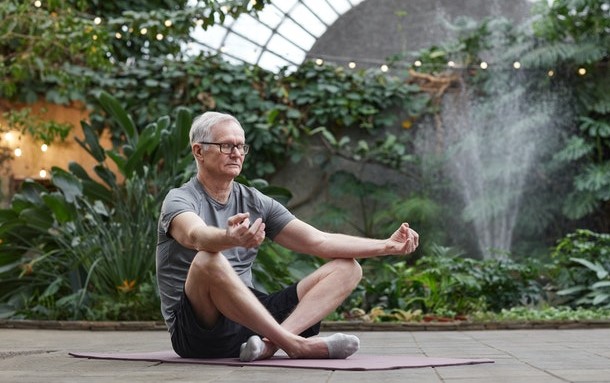
First, Full Yogic Breath
Share
Cane Fu, But First, Breathe
Before you kick, before you learn defensive arcs with your cane, learn to breathe. “Of course I’m breathing; I’m alive,” you react. We’re not talking about the light breathing of regular living. We’re talking about the kind of breathing that strengthens your lungs and gets the toxins out. Full yogic breathing is a great defense against the stress and health risks we face today. Reducing your stress and keeping your lungs and body healthy, are the best way to boost your immune system. You don’t have to be a fitness guru to start; we’ll train you. Take the time to learn to breathe the full yogic breath. You’ll be amazed at how much you will be able to do with your new energy and strength!

Yogic Breathing
Full yogic breath is your life force in yoga. During periods of stress, most of us begin to breathe in shallow breaths. We should do the opposite if we want to stay calm. Breathing deeply, with full yogic breaths keeps you clear headed and calm. You will be able to make more logical decisions and will be able to cope better. Yoga breathing is not like any other type of breathing, and has developed a huge following.
A wave of recent studies of yoga breathing techniques have revealed amazing benefits just from practicing yoga breathing techniques. These include improved blood pressure and restoration of energy levels. Yoga breathing is known to reduce anxiety and depression, stress induced cortisol levels, pain and relax muscles.
Full Yogic Breath
There are several popular breathing exercises in yoga, but we want to tell you the first essential breath to master. We are talking about the full yogic breath. Also known as the three-part breath, full yogic breath uses three lobes of lungs and affects three different torso sections. While you can practice this kind of breathing at any time, it is especially beneficial for five to fifteen minutes every day. Because you should perform the technique with an empty stomach, early morning is an ideal time to practice the full yogic breath.
Taking a Full Yogic Breath
Begin your full yogic breath with a deep inhalation that fills three sections of the torso separately. As you breath, focus on keeping the inhalation fluid from one section to the next. First breathe into the lower abdomen, followed by the diaphragm and ribs section. Then pull air into the upper chest as the inhalation portion of the round closes. Follow this slow, focused inhalation by a slow, soothing exhale. The inhalation and the exhalation should both be continuous. There should be no point where either causes any strain. Of course, it will take some time to develop a comfort with this breathing work. Full Yogic Breath, known as pranayama, is a practice. By performing the technique first thin every day, you can develop your capacity for moving the breath intentionally, and fluidly.
Get Comfortable
Find a comfortable position, either seated or lying. If seated, make sure you plant your pelvis onto the surface beneath you. Imagine your pelvic bones growing roots that go deep into the earth, or chair beneath you. If you are able to sit in the Vajrasana (sitting yoga position) pose, great. If not, lie on your back and relax your entire body. Close your eyes and relax for a moment. Close your mount and breathe only through your nostrils if you are able. Quiet your mind as you sink into the moment.
Practice with Intent
Think about your natural flow of breathing. Don’t change it yet, just observe it. After a moment, slowly inhale, drawing breath into your abdomen, then allow your breath to fill the entire area around your abdomen in all directions. Expand your breath to the diaphragm, expanding it, the ribs and the mid-back as breath continues to rise and expand. Once the mid-torso feels full, continue to inhale to fill the upper chest all the way up into the shoulders and base of the neck. Sounds easy, but it could take practice.
Expel the breath from the shoulders and upper chest first, as the heart, lungs, sternum and shoulders relax. Then drop down to the diaphragm continuing to release your breath down the spine to the lower abdomen area. When you have released your full breath, you have completed a round of Full Yogic Breath. Pause, then begin the process all over again, inhaling from the lower abdomen and working your way up.
Follow this process up to fifteen minutes and then allow your breathing to return to normal before opening your eyes and wrapping up your practice. Notice how you feel. As you become more comfortable with practicing Full Yogic Breath each day, you may discover you feel more refreshed, awake and relaxed as you complete the practice.
